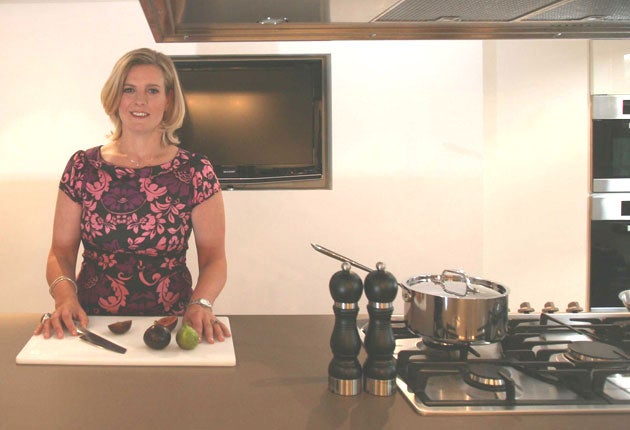What makes the perfect kitchen?
If you're serious about cooking, you need the right gear at your fingertips. Lyndy Redding, caterer to the stars, has it all worked out.

Anyone who has ever thought about redoing or designing their own kitchen will know that it's probably easier, less expensive and less traumatic just to move to a house that already has a kitchen you like. The number of different components – sink, oven, seating, surfaces, drawers, kettles, storage – and the mind-boggling range of choice within all those separate components would reduce even a decisive person to a twitching, nervous wreck.
Should you have granite surfaces? Or Chorion? Which are the best knives, the best pots and pans, the best food mixers to buy? Should you have a one-basin sink or a double butler?
Lyndy Redding, who owns Absolute Taste, one of the UK's biggest outside-catering companies, knows a thing or two about what you need for a good kitchen.
Absolute Taste started out catering for the McLaren Mercedes Formula One team at grands prix and now cater for other top clients. The company provided all the food for Nelson Mandela's 90th-birthday party, Gordon Ramsay's 40th-birthday party and Chelsea footballer John Terry's wedding.
Redding takes The Independent through her kitchen at home in London and gives some definitive answers to those tricky kitchen questions.
Triangle
Before you start designing a kitchen, you need to think about two things: first, what you do most in the kitchen; and second, you should arrange your chopping space, oven and fridge in a triangle so you can get to everything easily. In my kitchen, there are also dedicated "drinks" and "food areas", with their own fridges.
Knives
Chefs will continue to use the knives they trained with, so I've often used Sabatier knives, but they're heavy. Generally, I try to use a lightweight and well-balanced blade with a comfortable handle. And you must remember a knife is only as good as its sharpener. So never use a cheap pull-through sharpener – steel is always best.
Bin(s)
I've got two bins: one under the sink for peelings and other food waste; and a larger one in the utility, which is divided into compartments for recycling paper, glass and plastic. Something that a lot of people find useful is to have a hole cut in the work surface, with a stopper that can be removed. There's a bin underneath so that peelings can be swept through the hole and straight into the bin.
Island plugs
These electric plug towers are great and very useful. They are topped with a brushed metal handle so that when you don't need them they don't disturb the surface and lie completely flat to stop water and other general mess getting into the electrics. But when I need them I can pull them out easily and plug in my appliances.
Oven
An electric oven with a gas hob is the obvious combination. I chose to have a wall-mounted double oven rather than a range. The top oven doubles up as a microwave, and it has a grill and door at eye level so you can keep an eye on things without having to bend down. Plus I like to have an island to prepare food at – you can't really do that with a range and all the huge works underneath it.
Cooker
I have a five-ring gas hob. Some professional chefs have bigger ones than this but I don't think that's necessary. All you need is five rings of varying size and definitely a large one in the middle for putting large pots on. You must have gas – nothing else is any good. Electric hobs really lack control. Underneath the cooker are pan drawers, which have a shallow drawer at the top of the larger pan drawer, which contains cooking utensils.
Hydro tap
This tap dispenses cold, filtered water and water hot enough to make a cup of tea with, instantly. It means you don't have to have your kettle out, getting in the way, and you only use the amount of water that you need, rather than boiling a kettle every time; I think it also looks great. The downside is that it comes with a big box underneath the surface, and they are quite expensive.
Salt & pepper
There are some really ghastly gadget salt and pepper grinders on the market, such as the electric ones or the ones with lights on. They don't just look awful but are often poorly designed as well. For me, you can't beat a simple one with a tight action. Mine are made by Peugeot, who I think make the best.
Floor
The floor is tiled, which looks nice and is easy to clean. I'd always recommend tiles, because they are durable and easy to maintain. One downside is that they are very hard, so if you drop anything on them, it shatters immediately. The alternatives are rubber floor tiles or cork; things don't break as easily, but for me they just don't look as good.
Saucepans
Having a durable and easily cleaned saucepan is crucial for any chef. Copper-bottomed pans are great, because they have brilliant conductive properties, but avoid carbon-based saucepans: they salt-mark very easily and quickly look nasty. For stews and other slow cooking, Le Creuset pots are fine, but there are plenty that do just as good a job.
Sinks
As well as two bins, I've got two sinks. One, in the kitchen island, is for general food prep, and the other, in the side utility room, is for more serious washing-up. If you're a large family, it's probably best to have a double butler sink. In the large sink I've got a washing-up jet spray. Some people have those large, upright, curved sprays but I think this kind is small, neat and does just as good a job.

Join our commenting forum
Join thought-provoking conversations, follow other Independent readers and see their replies
Comments